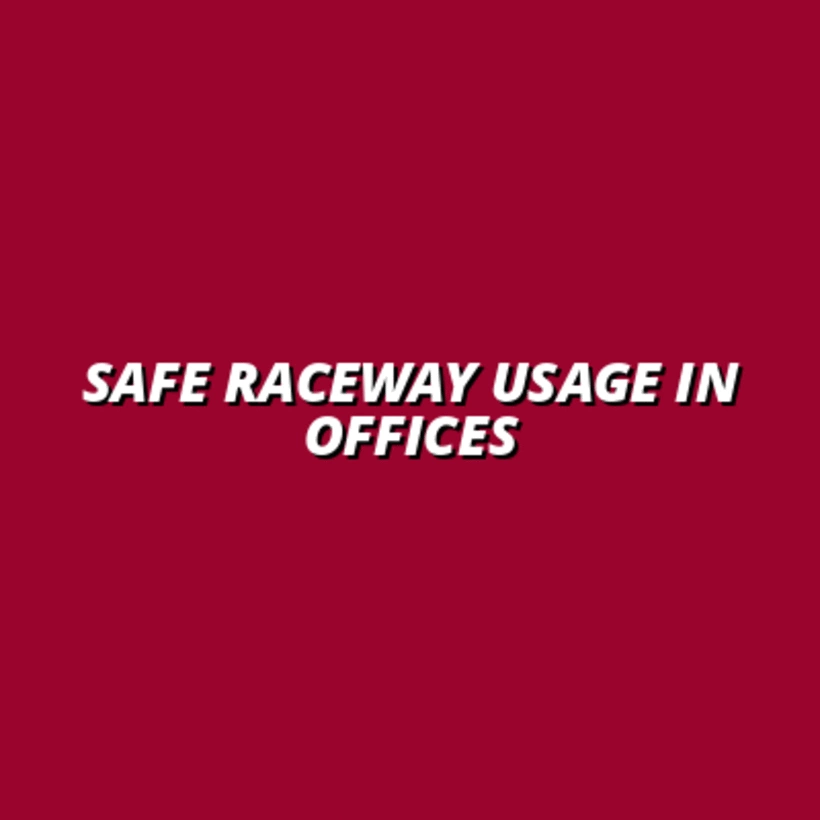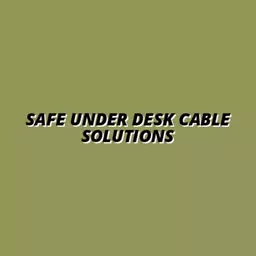
Safe Raceway Usage in Offices
In an age where workplace safety is of utmost importance, a staggering 80% of workplace accidents can be prevented by adhering to proper safety protocols. Understanding the role of electrical raceways in maintaining a secure office environment is crucial for every business. Let's delve into the key insights that can help foster a safe and organized workspace.
What You Will Learn
- Electrical raceways serve to organize and protect cables, reducing risks of damage and ensuring a clean workspace.
- Improper usage of raceways may lead to serious hazards, including electrical shocks and potential fire outbreaks.
- Adhering to raceway safety standards not only protects employees but also enhances workplace morale and productivity.
- Regular inspections and staff training are vital for identifying electrical hazards and ensuring compliance with safety regulations.
- Building a culture of safety in the workplace involves open communication, regular training, and involvement from all employees.
- Utilizing fire-resistant materials and avoiding overcrowding of wires in raceways are key practices for maintaining fire safety.
Raceway Safety Impacts on Office Environments
Understanding the critical benefits of adhering to raceway safety standards can significantly enhance workplace environments.
Long-Term Benefits of Raceway Safety
- Increased workplace morale due to a safer environment.
- Reduced costs associated with repairs and replacements.
- Improved productivity as employees feel secure.
Risks of Improper Raceway Usage
- Increased risk of electrical shocks.
- Potential fire hazards from overcrowded cables.
- Higher chances of equipment failures.
Compliance Benefits
- Legal protection from OSHA and NEC standards.
- Boosted employee morale and productivity.
- Financial savings through accident prevention.
Key Safety Practices
- Conduct regular safety training sessions.
- Encourage open dialogue about safety concerns.
- Incorporate safety practices into onboarding.
Understanding the Importance of Raceway Safety in Office Environments
When it comes to office spaces, ensuring safety is paramount, especially regarding electrical systems. One key component of this safety is the electrical raceway. These raceways not only organize cables but also protect them from damage, ensuring a tidy and secure workspace. Let’s explore what electrical raceways are and why their safe usage is essential.
Defining Electrical Raceways and Their Purpose
What Are Electrical Raceways?
Electrical raceways are channels designed for housing and protecting electrical wires and cables. They come in various materials, including metal and plastic, and can be found in different shapes, such as J-channels or raceways. By keeping cables organized and out of sight, raceways help maintain a clean workspace while also reducing the risk of interference and damage.
Common Applications in Office Settings
In office environments, raceways are commonly used for:
- Running power and data cables along walls or under desks.
- Providing easy access to wiring for maintenance or upgrades.
- Creating a streamlined look that enhances the overall aesthetics of the workspace.
By implementing raceways effectively, offices can maintain both functionality and visual appeal. Imagine walking into a workspace where cables are neatly tucked away — it’s a breath of fresh air!
Why Raceway Safety Matters in Offices
The Risks Associated with Improper Raceway Usage
Using raceways improperly can lead to significant dangers, including electrical shocks and fire hazards. When cables are not adequately secured or are overcrowded, the risk of overheating increases. This could lead to equipment failures or even fire outbreaks, which are costly and dangerous for everyone in the office.
For more information on preventing fires related to cable management, see our article on organizing cables to prevent fires.
Long-Term Impacts of Adhering to Safety Standards
Adhering to raceway safety standards not only protects employees but also safeguards the business’s reputation. Following proper guidelines helps avoid accidents and can lead to:
- Increased workplace morale due to a safer environment.
- Reduced costs associated with repairs and replacements.
- Improved productivity as employees feel secure in their workspace.
At Under-Desk Tray Hub, we believe that every workplace deserves to be both functional and safe. Ensuring your raceways meet safety standards is a step toward that goal!
💡 Want to master under-desk cable trays? Start with our foundational guide to all things cable management. 👉 Read the Cable Management 101 Guide
Frequently Asked Questions (FAQs)
- What are electrical raceways?
- Electrical raceways are channels designed to house and protect electrical wires and cables, ensuring a tidy and secure workspace.
- Why is raceway safety important in offices?
- Raceway safety is crucial to prevent electrical shocks, fire hazards, and equipment failures, safeguarding employees and business reputation.
- What are the long-term benefits of adhering to safety standards?
- Adhering to safety standards increases workplace morale, reduces costs associated with repairs, and improves overall productivity.
- How can electrical hazards be minimized in the office?
- Regular inspections, adherence to safety practices, and proper raceway installation can significantly reduce electrical hazards in the workspace.
- What role does staff training play in raceway safety?
- Staff training ensures employees understand proper installation techniques, potential hazards, and emergency procedures, promoting a safety-conscious workplace.
- What should be considered for fire safety in raceway applications?
- Key considerations include avoiding overloaded wires, using fire-resistant materials, and conducting regular inspections for signs of wear or damage.
The Role of Electrical Hazards in Office Safety
Electrical hazards can arise from various sources, including faulty wiring and improper raceway installation. Identifying these hazards is essential for maintaining a safe workspace. Regular inspections and adherence to safety practices can significantly reduce these risks, ensuring a secure environment for all employees.
Understanding Fire Safety in Raceway Applications
Fire safety is critical when using raceways. Here are some key considerations:
- Ensure that raceways are not overloaded with wires.
- Use fire-resistant materials when possible.
- Regularly inspect raceways for signs of wear or damage.
By prioritizing fire safety in raceway applications, you can protect not only your equipment but also the well-being of everyone in the office. It’s about creating a workspace that’s safe and free from unnecessary risks!
For more insights on how to enhance workspace safety, check out these simple DIY cable management tips from our accessories subdomain.
Quick Summary
Here's a brief recap of the key points discussed so far:
- Electrical raceways organize and protect cables, reducing hazards and improving aesthetics in office settings.
- Improper usage of raceways can lead to electrical shocks and fire risks, highlighting the need for safety compliance.
- Adhering to safety regulations enhances employee morale, reduces costs, and fosters a culture of safety within the workplace.
Summary of Safe Practices for Using Raceways in Office Spaces
In today’s busy office environments, ensuring raceway safety is not just a good practice—it’s essential! By following best practices and adhering to safety regulations, we can create a workspace that is not only efficient but also secure. At Under-Desk Tray Hub, we believe that a clutter-free and safe workspace contributes immensely to productivity and peace of mind.
Building a culture of safety in the workplace involves everyone, from management to individual employees. It starts with understanding the importance of adhering to safety regulations. Everyone should be aware of the guidelines that govern raceway installations and maintenance. By fostering an environment of accountability and care, we can prevent accidents before they happen!
Reinforcing Compliance and Best Practices
Adhering to safety regulations not only protects your employees but also helps maintain a healthy work atmosphere. Here’s why compliance is crucial:
- Legal Protection: Following OSHA and NEC standards shields your company from potential legal issues.
- Employee Morale: A safe environment boosts morale and encourages productivity.
- Financial Savings: Preventing accidents reduces costs related to injuries and repairs.
Furthermore, building a culture of safety begins with clear communication. Regular meetings and updates about raceway safety can keep this important topic top of mind. It’s not just about compliance; it’s about creating a safe haven for everyone in the office!
Importance of Adhering to Safety Regulations
Understanding and following safety regulations is vital for the longevity of your raceway systems. Each workplace is unique, so it’s critical to tailor your approach to fit the specific needs of your environment. Regularly reviewing safety standards ensures everyone is on the same page.
To ensure your electrical setup is up to par, learn more about essential wiring standards with tips from our power subdomain.
Creating a safety-first mindset can significantly enhance your workspace. It’s essential to make safety a part of everyday conversations and practices. Encourage your team to share ideas on improving safety measures; sometimes, the best solutions come from those who work in the trenches!
Building a Culture of Safety in the Workplace
Establishing a culture of safety requires commitment from everyone involved. Here are some steps you can take:
- Conduct regular safety training sessions.
- Encourage open dialogue about safety concerns.
- Incorporate safety practices into your onboarding process for new hires.
By creating a strong safety culture, you’ll not only comply with regulations but also foster an environment where employees feel valued and secure.
For more on this, consider exploring further resources on enhancing office safety with cables.
Role of Staff Training in Raceway Safety
Staff training is the cornerstone of a safety-conscious workplace. It ensures that everyone is equipped with the knowledge and skills necessary to prevent accidents. Regular training sessions should cover:
- Proper installation techniques for raceways.
- Understanding potential hazards and how to avoid them.
- Emergency procedures related to electrical failures.
Training empowers employees to take ownership of their safety and the safety of those around them. Remember, a well-informed team is a safer team!
Call to Action: Ensuring Safety in Your Office Today
Are you ready to make a positive change in your office? Encouraging proactive risk management is a great start! Assess your current raceway systems and identify areas for improvement. By integrating safety into your daily operations, you’ll not only protect your employees but also enhance your overall office environment.
For further learning on raceway safety, check out resources like OSHA’s official website and local building codes. At Under-Desk Tray Hub, we’re dedicated to providing you with the tools and information you need to create a safe and organized workspace. Let's work together to make our offices safer—because a tidy workspace is a happy workspace!
Recap of Key Points
Here is a quick recap of the important points discussed in the article:
- Understanding Electrical Raceways: Electrical raceways are essential for organizing and protecting cables in office environments.
- Safety Matters: Proper usage of raceways can prevent electrical shocks and fire hazards, ensuring a safe workspace.
- Compliance with Regulations: Adhering to safety standards like OSHA and NEC protects employees and minimizes legal risks.
- Building a Safety Culture: Encourage open communication and regular training to foster a culture of safety among staff.
- Regular Inspections: Conduct routine checks of raceways to identify potential hazards and ensure they are in good condition.
- Fire Safety Considerations: Use fire-resistant materials and avoid overcrowding raceways to minimize fire risks.




